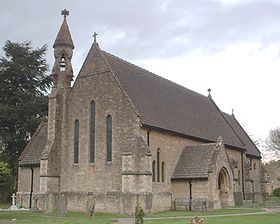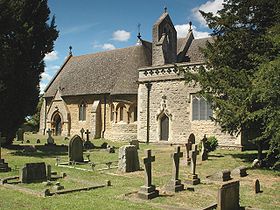- Clapton Crabb Rolfe
-
Clapton Crabb Rolfe Born 1844 or 1845[1] Died 18 December 1907
Wheatley, Oxfordshire[1]Nationality British Work Buildings St. John the Evangelist parish church, Hailey, Oxfordshire
All Saints' parish church, Nuneham Courtenay, OxfordshireProjects King Edward VI Grammar School, Nuneaton Clapton Crabb Rolfe was an English Gothic Revival architect whose practice was based in Oxford.
Contents
Family
C.C. Rolfe was the second of nine children. His father was Rev. George Crabb Rolfe (1811–93) who was perpetual curate of Hailey, Oxfordshire from 1838 until his death.[2] His mother Ellen was a sister of the architect William Wilkinson.[2] C.C. Rolfe's elder brother George Wilkinson Rolfe (1843–1912) followed their father into the clergy[2] and a younger brother William Andrew Rolfe (b. 1850) became an architect.[2] In 1873 C.C. Rolfe became married to Annie de Pré, who bore him one son, Benedict Hugh Rolfe (b. 1874).[2] B.H. Rolfe trained as an architect and assisted with some of his father's later works, but settled in London as a consulting engineer.[2] C.C. Rolfe died in 1907. Both he and Annie are buried in the parish churchyard of St. Mary's, Wheatley, Oxfordshire.[2]
Note: the Buildings of England series of architectural guides spells C.C. Rolfe's middle name "Crabbe" but other authorities use "Crabb",[1][2] and the latter spelling is used in this article. A memorial plaque in Hailey parish church to his father Rev. G.C. Rolfe also says "Crabb".
Career
Much of Rolfe's work was for parish churches and other institutions of the Church of England. His first major commission was to design a new parish church at Hailey for his father.[3] His design was in a freely reinterpreted French Gothic style,[3] and the Oxford Diocesan Architect G.E. Street condemned Rolfe's first draft as "needlessly eccentric".[3] Despite Street's objections Rolfe completed the church with some unusual details, including a strangely-shaped bell-turret.[4]
Rolfe's work is notable for its quality and detail. In Rolfe's reconstruction of part of the nave of Nuneaton Abbey and his restoration of All Saints parish church, Thorpe Malsor, the craftsman Harry Hems (1842–1916) undertook the carving.[2] Hems was a craftsman who originated from Yorkshire[5] but from 1866 worked in Exeter.[6] He carved for Rolfe again on the restorations of St. Giles' parish church, Standlake in 1880–91, St. Martin's parish church, Chipping Ongar in 1884, and St. Michael's parish church, Inkpen in 1896–97, and also on Rolfe's new chapel for the Sisterhood of Saint Thomas, Oxford in 1888.[2]
C.C. Rolfe was made an Associate of the Royal Institute of British Architects in 1869.[1] In 1881 G.E. Street died and Rolfe was one of the applicants to succeed him as Oxford diocesan architect.[2] John Oldrid Scott was the successful applicant, but Rolfe was later appointed Oxford Diocesan Surveyor.[2]
Rolfe was a devout Anglo-Catholic who sought to translate his faith into his building work.[2] In 1871 he wrote in The Builder:
Those professional men nowadays who despise and ridicule that pure symbolic spirit which actuated our forefathers in their church-work, and probably substitute for it that £sd money-grubbing spirit of the age, are alike unfit and unworthy of being engaged on any modern church-work whatever.[7]
Rolfe wrote a number of publications on aspects of church architecture and furnishing, but has he got older the style and content of his writing became increasingly obscure.[2]
Works
Buildings
- Saint John the Evangelist, Hailey, Oxfordshire: new church, 1868–69[8]
- Old Church, Churchill, Oxfordshire: east window, 1869[9]
- 114-138, 149-156 and 159-164 Kingston Road, Oxford: terraces of artisan houses, 1870–75[10][11][12]
- Ascott-under-Wychwood: village school, 1871[13]
- Leafield, Oxfordshire: extension to village school, 1871[2]
- All Saints, Nuneham Courtenay: new church, 1872–74[14]
- Holy Trinity, Rayleigh, Essex: restoration of chancel, 1873[2]
- Saint John the Baptist, Curbridge, Oxfordshire: added apse to chapel, 1874 (demolished 1906)[2]
- Saint James's College, South Leigh: 1875 (later part of Holyrood Hospital)[15]
- Saint Peter, Mancetter, Warwickshire: restoration, 1875[2]
- Nuneaton Abbey, Warwickshire: new vicarage and reconstruction of part of nave, 1877[2]
- All Saints, Thorpe Malsor, Northamptonshire: restoration, 1877[2]
- Saint Margaret, Eglwyscummin, Carmarthenshire: restoration, 1878[2]
- King Edward VI Grammar School, Nuneaton, Warwickshire: new buildings, 1879–80[16]
- Saint Giles, Standlake, Oxfordshire: restored church, 1880–91[17]
- Saint Lawrence, Appleton, Berkshire (now in Oxfordshire): restored nave, 1882–84[2]
- Saint Martin, Chipping Ongar, Essex: south aisle, 1884[2]
- Holy Rood, Shilton, Oxfordshire: restored church, 1884–88[18]
- Sisterhood of Saint Thomas, Oxford: new buildings, 1886[19] (demolished 1969)[2]
- 29 Abbey Road, Oxford: house, 1886–87[20]
- Saint Denis, Northmoor, Oxfordshire: partial restoration, 1886[2] or 1887[21]
- Holywell Ford, Mill Lane, Oxford: house, 1888[22]
- Saint Thomas, Oxford: vicarage, 1893[19]
- Barnett House, Turl Street, Oxford: house on corner of Broad Street, 1889 (demolished 1960's)[2]
- Holy Rood, Cuxham, Oxfordshire: rebuilt chancel, 1895[23]
- Saint Michael, Inkpen, Berkshire: restored and remodelled church, 1896[24]
- Saint Nicholas, Dormston, Worcestershire: restoration, 1899[2]
Written works
- Chancels, Screens and Roods (pamphlet). Reading: 1877.[2]
- The Ancient Use of Liturgical Colours. Oxford & London: Parker & Co. 1879.
- Ecclesiastical Dilapidations, a Handbook for the Clergy. London: Simpkin, Marshall. 1883.
- The Liturgical Use of Incense, an Eirenicon by C. C. R., with Preface by the Rt. Honourable Earl Nelson. London. 1900.[2]
References
- ^ a b c d Brodie, page 187
- ^ a b c d e f g h i j k l m n o p q r s t u v w x y z aa ab ac Saint, 1970
- ^ a b c Sherwood & Pevsner, 1974, page 628
- ^ Sherwood & Pevsner, 1974, page 629
- ^ Exeter Memories: Harry Hems – ecclesiastical sculptor and wood carver
- ^ The Harry Hems Centre: Building History
- ^ Rolfe, 1871
- ^ Sherwood & Pevsner, 1974, page 558
- ^ Sherwood & Pevsner, 1974, page 545
- ^ Sherwood & Pevsner, 1974, page 325
- ^ Tyack, 1998, page 237
- ^ North Oxford Victorian Suburb Conservation Area Draft Appraisal, page 20
- ^ Sherwood & Pevsner, 1974, page 423
- ^ Sherwood & Pevsner, 1974, page 726
- ^ Sherwood & Pevsner, 1974, page 770-71
- ^ Pevsner & Wedgwood, pages 365-366
- ^ Sherwood & Pevsner, 1974, page 777
- ^ Sherwood & Pevsner, 1974, page 755
- ^ a b Sherwood & Pevsner, 1974, page 329
- ^ Sherwood & Pevsner, 1974, page 335
- ^ Crossley & Currie, 1996, pages 166-170
- ^ Sherwood & Pevsner, 1974, page 331
- ^ Sherwood & Pevsner, 1974, page 568
- ^ Pevsner, 1966, pages 158-159
Sources
- North Oxford Victorian Suburb Conservation Area Appraisal Draft. Oxford: Oxford City Council. p. 20.
- Brodie, Antonia; Felstead, Alison; Franklin, Jonathan et al., eds (2001). Directory of British Architects 1834–1914, L–Z. London & New York: Continuum. p. 187. ISBN 082645514X.
- Crossley, Alan & Currie, C.R.J. (eds.); A.P. Baggs, Eleanor Chance, Christina Colvin, C.J. Day, Nesta Selwyn, S.C. Townley (1996). Victoria County History: A History of the County of Oxford, Volume 13: Bampton Hundred (Part One). pp. 166–170.
- Pevsner, Nikolaus (1966). The Buildings of England: Berkshire. Harmondsworth: Penguin Books.
- Pevsner, Nikolaus; Wedgwood, Alexandra (1966). The Buildings of England: Warwickshire. Harmondsworth: Penguin Books.
- Rolfe, C.C. (1871). The Builder 29: 471.
- Saint, Andrew (1970). "Three Oxford Architects". Oxonensia (Oxfordshire Architectural and Historical Society) XXXV: 53 ff.. http://www.oahs.org.uk/oxo/vol%2035/Saint.doc. Retrieved 3 November 2009.
- Sherwood, Jennifer; Pevsner, Nikolaus (1974). The Buildings of England: Oxfordshire. Harmondsworth: Penguin Books. ISBN 0 14 071045 0.
- Tyack, Geoffrey (1998). Oxford An Architectural Guide. Oxford & New York: Oxford University Press. p. 237. ISBN 0-19-817423-3.
Categories:- 1907 deaths
- Gothic Revival architects
- English ecclesiastical architects
Wikimedia Foundation. 2010.


